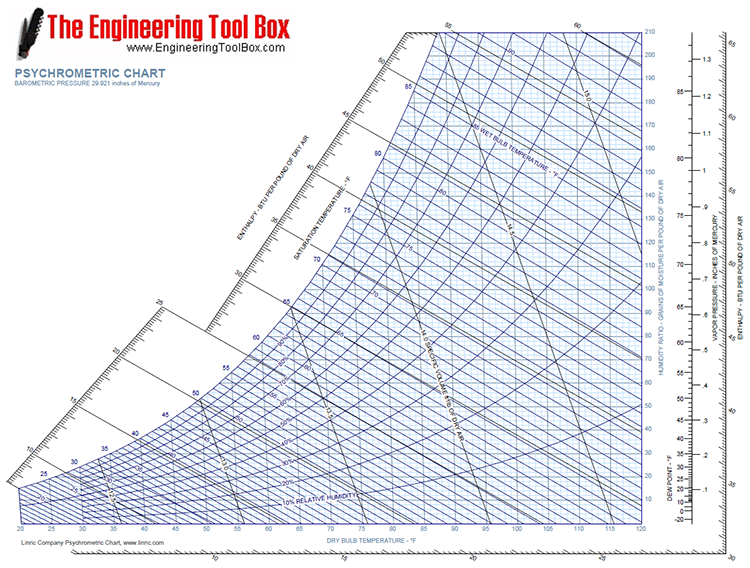Solar desiccant cooling systems focus on the dehumidification of air as a means of cooling air for a building space. Psychrometrics is the field of engineering concerned with the amount of moisture (as vapor) in the atmosphere. To understand psychrometrics, we use a psychrometric chart, below (there are many charts available free online from various sources and companies. (The following chart is from engineeringtoolbox.com). Use the following link to access a scalable PDF file of the psychrometric chart.
The x-axis here is dry bulb temperature (this is the temperature measured by thermometer shielded from radiation or moisture - true thermodynamic temperature). The y-axis is water content, or moisture, measured in mass of water per unit mass of dry air. As you move to the left on the chart, you decrease the sensible heat. As you move to the right, you increase the sensible heat. As you move up you increase the humidity, increasing latent heat. As you move down you decrease the humidity.
You can learn the anatomy of the the psychrometric chart in more detail from the following source:
Reading Assignment:
Website: Psychrometric Charts, Autodesk Education Community, URL: http://sustainabilityworkshop.autodesk.com/buildings/psychrometric-charts
The psychrometric charts help to understand how the solar desiccant cooling works. This is the second class of solar cooling systems, which are based on humidification-dehumidification process using a hygroscopic material (desiccant), which is capable of absorbing moisture from air. This cycle uses water in the direct contact with air as refrigerant. Both liquid or solid desiccant can be used: for example, silica gel, LiCl salt (solid) or glycol, LiCl solution (liquid). An interesting feature of the desiccant cycle is that it is an open system, meaning that water (refrigerant) is discarded from the system via dehumidification process, and then new water is taken in during humidification phase. The desiccant cycles are typically used with flat-plate solar collectors. Solar heat is applied to regenerate the desiccant.
Learn more details about how desiccant cycle works from the following reading:
Reading Assignment:
Duffie, J.A., and Beckman, W.A., Solar Engineering of Thermal Processes, Wiley and Sons, 2013, Chapter 15, Sections 15.7-15.8.
Sahlot, M and Riffat, S.B., Desiccant Cooling Systems: a Review, Int. J. Low Carbon Tech., 2016, pp. 1-17.
Figure 15.7.2 in the D&B text shows the psychrometric path through a rotary desiccant solar cooling system, with numbers tagged on the chart that correspond with the numbers tagged on the system diagram. Figures 15.8.1 and 15.8.2 in the D&B text each show an additional system configuration that uses a desiccant and the subsequent psychrometric chart path that results from the use of the system. Revisit each of these three figures and follow the path through the system on the psychrometric chart.

